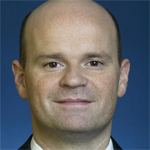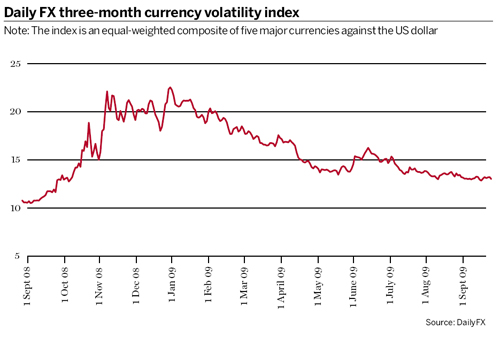While investors remain cautious, Frances Maguire finds that they are looking to the foreign exchange market for its low correlation with the equity market and using structuring to access it.
Until 2008, the foreign exchange market was largely dominated by carry trades, where investors take advantage of the interest rate differentials between currencies. However the extreme volatility in the FX and interest rate markets prompted banks to offer alternatives through indices and baskets on which to offer investors structured products.
One of the first movers, last November, was BNP Paribas, which launched FX indices Galaxy Alpha and Alpha Plus as an alternative to the traditional carry trade strategies. The indices were designed to extract outperformance between a dynamic basket, selected every month based on the currencies with the highest interest rate differentials, and a fixed benchmark basket of traditional currency pairs.
At the beginning of this year, there were some high profile exits from the market, such as UBS's decision to close down its exotic structured products business within its fixed income, commodities and currencies division. Even so, interest in first- and second-generation exotic options structures showed signs of revival as clients looked to cut costs of vanilla options.
Also, in April this year, Credit Suisse launched its FX Factor index, designed to provide exposure to a portfolio of macroeconomic and market-driven FX strategies and offering structured products, such as Delta-1 trackers and capital-protected trades, linked to the index.
Exchange-traded products
Additionally, cleared exchange-traded FX products saw renewed interest as they offer investors price transparency and depth of liquidity, alongside the safety for investors in terms of counterparty risk. Several futures exchanges offer small-sized currency contracts, designed to attract the self-directed retail investor.
The CME Group offers trading in 41 currency pairs and from the outset the products were designed and sized with the individual trader in mind. Even though the standard currency contract size, at €125,000, is considered small by institutional traders, CME has also launched e-mini contracts, half the standard size, for the dollar, yen and eurodollar contracts, in recent years to broaden access further. As a result, CME Group now has about 85% market share of exchange-traded FX products globally and about 97% in North America.
Bert Korevaar, head of retail and public distribution at Royal Bank of Scotland, says that there has been an increased interest in FX-listed structured products from retail investors since last October, when there was a lot of volatility in all currencies. He says: "Although the trend has slowed in the past few weeks because the volatility is moving away slightly, there is clearly significant interest in FX-related products on FX trading platforms, trading spot FX, CFDs [contracts for difference] and options, as well as FX warrants and mini-futures on exchanges."
He adds that interest is also growing in investment products, such as capital-protected structures based on FX, either an index or a play towards the inverted market.
Mr Korevaar also says that there is a greater awareness of counterparty risk among retail investors, post-crisis, but as the structures used by retail investors tend to be relatively vanilla and transparent, with clear, liquid prices, they are more than comfortable trading structured products.
However, Mr Korevaar believes it is too early to say whether there will be a big shift towards listed products because FX is such a liquid market and the lion's share of FX products are used for trading purposes, more than investment, and therefore generally held for shorter periods. He says: "I think we will see a growth in the use of listed FX-related products from private investors but this is more because of the interest in FX as an underlying rather than a shift from OTC [over-the-counter] to listed products."
Reducing options premiums
Structures used in FX range from exotic FX option types offering varying levels of protection on cross-currency rates to combinations of average rate options with short-dated overnight index swaps. The structuring of FX products also enables users to manage their exposure in a single trade, which is often more cost-effective than having to handle money-market or fixed-income products separately from their FX products.
According to Rene Schwarzl, vice-president in FX structuring at Citi, much of the FX market has been driven by carry trade products. "Many of these carry trades have been delivered via baskets of currencies, and we have seen high demand from institutional and private investors."
He adds: "Volatilities have declined since reaching new peaks during the financial crisis and option volumes are increasing again as investors are attracted back to the market due to their relative cheapness."
Additionally, Ilyas Ayub, vice-president for structured products at Citi, notes demand for FX investments has come from the private client segment. "These investors are generally more comfortable in using currencies to enhance returns, and high-net-worth investors particularly have more confidence in sophisticated structures such as outperformance products. Retail clients have developed some appetite for vanilla products such as BRIC [Brazil, Russia, India and China] baskets. FX is now being seen as an investable asset class in its own right, beyond its historical use as a pure portfolio hedge," he says.
Citi distributes its FX-linked products through its internal channels as well as third-party networks, with pricing available on Reuters and Bloomberg.
In terms of products and structures, Citi is seeing interest in dynamic FX strategies from retail and institutional investors and offers a variety of FX trading strategies that are available in many formats such as swaps, notes, options or UCITS III funds.
James Davison, head of FX structuring for Europe, BNP Paribas
Emerging FX appeal
The 'old world/new world' story is also proving popular, particularly in light of macroeconomic news, where Citi reports seeing flows from private investors who are focusing on emerging market currencies due to the growth potential in these regions.
James Davison, head of FX structuring for Europe at BNP Paribas, says that since the start of the crisis, there has been a renewed interest in FX as an asset class, particularly among those asset managers who had previously focused almost entirely on equities and bonds. "The size and relative liquidity of currency markets, coupled with the low correlation of FX to other asset classes, has served to further highlight the diversification benefit of FX in the current climate," he says.
While the low interest rate environment has encouraged investors to seek alternative means of achieving yield enhancement, there has been a general move away from the types of complex products that were popular in 2007 and 2008, in favour of simpler, more vanilla products.
Mr Davison says: "Investors have increasingly been looking for instruments which will give them exposure to FX as an asset class, without having to actually take a view on a specific currency pair. This has led BNP Paribas to create a range of 10 easy-to-trade static FX indices that provide investors with a measure of the relative strength of a given reference currency against a basket of other currencies."
The bank is currently developing, and close to launching, two FX electronic platforms - one for spot FX, swaps and forwards, and another to deliver FX structured products and options electronically.
The biggest advantage of the OTC structured products market is that it allows banks to tailor-make their product offering to the individual needs of their clients, taking into account risk appetite and suitability. Mr Davison adds that the current environment of a spot FX moving back into a range has led to a return in appetite for some of the more sophisticated structured products in recent months. In particular, there has been renewed interest in products that express a view on the BRIC currencies and other general carry trade ideas.
"While the low interest rate environment has encouraged investors to look to structured products to enhance yield, the high levels of volatility seen on FX markets at the beginning of the year was seen more as a risk than an opportunity. Now that volatility on FX markets has returned to more normal levels, we are seeing increased demand once again for principal-protected products, providing a potentially enhanced return based on the investors' view of a particular currency or basket of currencies. Such products feature embedded options in order to floor the potential return at zero, thereby fully protecting the investors' capital" he says.
Tamas Korchmaros, head of FX index and investor products, currency structuring at RBS Global Banking and Markets, agrees that the high volatility and subsequent low interest rates kept a lot of investors away from the structured products market at the end of last year and well into this year, but risk appetite is returning. "Despite the current low interest rate environment, the enhanced funding is giving investors enough yield that can be exchanged for a pay-out."
He believes investors relate to RBS's long-term macro theme, 'the collapse of the currency pyramid', which is dollar-bearish in the belief that the dollar may ultimately lose its status as the world's main reserve currency.
Mr Korchmaros says: "This process started as far back as eight years ago and has been gradual. However, the recent financial crisis may lead to a tipping point that would cause the collapse of the dollar. Our approach in the currency pyramid analyses the possible triggers to such a scenario and the impact on clients. For this reason we have transacted dollar-bearish products versus some of the G10 and emerging market currencies, such as the BRIC currencies and gold."
Diversifying portfolios
Mr Korchmaros adds that much of the recent interest in FX is coming from the need to diversify portfolios, and currencies are seen as a good alternative to equity investments, due to both the low correlation and high liquidity. RBS is targeting a wide range of investors, including high-net-worth individuals and asset managers with its structured currency products.
"Some of the standard equity pay-outs that these clients are familiar with can be translated into FX products, with a currency underlying, and this is one of the approaches we are taking," he adds.
For this reason he says that auto-callable and auto-switchable structures are proving popular because if performance of the underlying has surpassed a certain level, after the first observation period, a coupon is paid out and the note is terminated. If the underlying does not reach the targeted performance in that period, then there is no coupon but the product continues to the next observation date, when it is assessed again. The client receives twice the coupon and the note is auto-redeemed if the targeted performance was reached. This process continues until the maturity date.
The risk is if the performance is never reached. In this case the original invested amount is redeemed at maturity without a coupon; the upside is an uplifted coupon and return of principal at an earlier stage than anticipated. It can also be structured as a 100% principal protected note or as a non-principal protected note depending upon the investor's risk appetite.
John Bartter, head of options and structured products in e-commerce sales, Deutsche Bank
Structured deposits
Deutsche Bank has developed an electronic dealing platform for structured deposits to enable wealth management clients to trade structured FX investment products via Autobahn FX, the bank's proprietary platform for FX trading.
Deutsche Bank has been offering FX yield enhancement products to global wealth management clients for more than 10 years, says John Bartter, who oversees options and structured products in e-commerce sales. The growth in use of these products led to the automation of these products on to the autobahn platform to allow Deutsche Bank's wealth management sales force to price and trade these products online and externally.
Clients can now trade FX structured deposits such as the dual currency investment (DCI), a short-term, fixed-rate deposit that offers higher returns than are available on money-market deposits in exchange for investors accepting the risk that the principal might be repaid in a different currency.
The Deposit Plus product is an alternative to the DCI, where only the principal gets converted and the coupon gets paid in the original currency. Here, the investor forgoes the possible yield or interest that could have been achieved via a standard money market investment in return to achieve a higher yield. Variants on these products can include barriers and knock-outs to customise products based on clients' risk appetite.
Mr Bartter says: "These products thrive in the kind of environment we have had in the past year - a low interest rate environment, need for liquidity and risk aversion. Most of the tenors of these trades are one month, and they deal in smaller amounts compared to traditional structured products, so from a liquidity perspective clients are not locking up their cash for long periods. Banks with good credit ratings stand out in this market, as this is where the money is being deposited."
While risk profile in the options market has moved to more standard options and conservative strategies, Mr Bartter says the appetite for options has remained strong.
Wealth management clients are becoming more sophisticated in their use of FX options and he believes that while clients shifted back into more conservative strategies, they are showing greater interest in a wider spectrum of option strategies with different risk profiles.
Mr Bartter says: "The beauty of options, and structured products, is that the risk profile can be anything from conservative to high risk. Structured deposits are a growth area because the risk profiles are usually conservative, predominantly short-dated and with the opportunity to commit smaller investment amounts."
At the other end of the market, institutional investors are looking to use complex and synthetic structured products as an alternative way of accessing FX as an asset class.
Mark McDonnell, head of prime brokerage at SEB Merchant Bank, says that institutional investors are recognising the risks and potential value they have in foreign exchange exposures linked to underlying asset positions, and there has been a huge growth in currency overlay management, either for hedging or the use of enhanced overlay strategies as a source of incremental yield.
As a result, prime brokers are offering alternative ways to access the asset class. Rather than buying a fund or using managed accounts, the trend is now to offer institutional investors more synthetic-based prime brokerage solutions and more FX-linked products, such as total return swap (TRS) methodologies, note and certificate-based products.
Mr McDonnell says: "Prime brokers need to develop the ability to create and service these types of products on an ongoing basis and provide more cost-effective, more expedient, and more transparent access to the asset class than could have been achieved using more traditional methods of access."
Overlays and FX-linked notes
Using TRS-based structures, the investor would make a notional allocation to the overlay manager, the overlay manager would then trade within that and the prime broker would pass the performance of that allocation back to the investor. These types of structures deliver significant benefits to the investor by circumventing the traditional route of opening and maintaining a managed account, and the costs associated with that and, depending on the credit quality of the investor, can avoid the need to unwind other positions to fund initial and ongoing margin requirements.
However, this model has evolved. Where institutional investors wanted to allocate FX on a fully funded basis, or if they wanted to buy into a panel of currency managers rather than buying into a fund, all the allocations can be packaged into a bond, issued by an issuer of the investors' choice or the prime broker, to overcome the operational stresses. This effectively re-wraps allocations to single or multiple currency strategies into a single product which can be settled via the various clearing systems, that can be priced daily and maintains the liquidity provisions of the underlying currency investment.
Working between the investor and the currency overlay manager to come up with a solution that meets all of the operational, leverage and funding requirements of the structures, Mr McDonnell says that SEB is putting the technology in place to support these more synthetic swap and note-based products. Other variations of structures also include currency index swaps or notes.
Mr McDonnell says: "Using the liquidity and transparency of the FX market avoids a lot of the difficulties that are associated with other types of structured markets where there is a lack of transparency, a lack of a two-way market and a lack of liquidity. This way, the manager and the structure can give daily liquidity and positions can be effectively unwound with a day's notice."
Just as the sheer size of the FX market is prompting new investors to enter the market, it is also enabling new structures to be designed, made possible by the deep liquidity that the market offers.
Coupled with the low correlation to the troubled equity market, banks are increasingly prioritising it in terms of investment in trading technology and viewing it as an area tipped for growth - something both investors and banks alike are desperate to see in the current climate.





